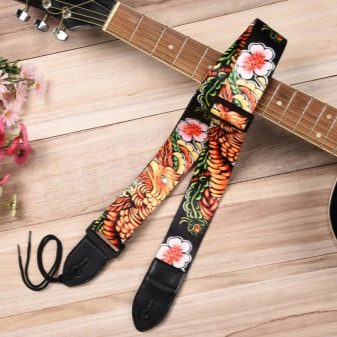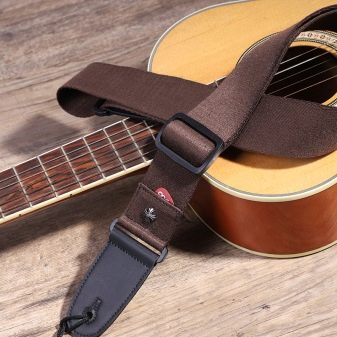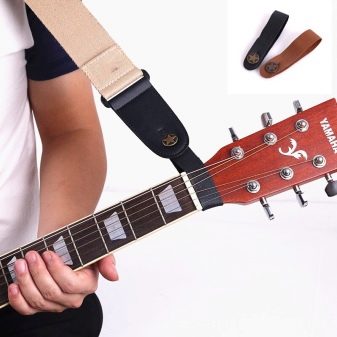Guitar Straps

Probably, any modern guitarist who has performed in public at least once understands perfectly well that it is fundamentally important to use a well-chosen, most practical-to-use strap for his guitar. Such a device can be purchased not only for active live performances. The constant alternation of active activities in the usual conditions at home - sitting or standing - can bring a much greater effect. Most likely, you will feel your instrument much better, you will be completely free to navigate with your fingers on the entire neck in the future. Finally, you can, as always dreamed of, learn to play “blindly” without difficulty, for a long period of time, in general, without looking at your hands and at the instrument itself.


Species overview
The belts themselves, as well as the subtypes of their fastenings, differ in direct dependence on what type of tool the tool belongs to.
Classic Guitar Strap
Such a device can be found most rarely today. Outwardly, it will very much resemble a familiar men's tie, and all because it pounces on the neck. Such a product is fixed to the instrument with special small hooks on special rubber Velcro (due to the lack of special lugs, as on acoustic instruments or electric guitars) for the upper and also at the same time for the lower edge of the resonator hole.It is not difficult to guess why such an original type of belt is considered rare, since usually guitarists who use the classical guitar in their activities perform most, if not all of their compositions, sitting. This means that much more often they do without any belt or any other device for support.


Products for acoustics
Usually, 2 ears are made on acoustic guitars: at the very heel of the neck and on the very body of the instrument. For those guitars that do not have one of the possible mounts, there are separate types: on the one hand, there is a special hole for the eyelet, and on the other, there are additional strings that are carefully tied to the headstock itself in close proximity to the first fret.


Products for electric guitars
There are always 2 ears, and it is this circumstance that allows you to choose an excellent accessory from a large number of possible options.


By strap width
Popular belts made from a material such as polyester or equally popular nylon usually vary in widths up to 5 cm. With their active use on rather heavy bass guitars, this width is quite enough to hold the instrument in use with its weight.
If you do not like synthetic materials, then you should look for more expensive and reliable leather goods.


Their width will greatly delight you. It can be up to 10 cm, which will provide complete safety for any guitar during its operation.
From the first try, and even for a not quite experienced guitarist, it will be quite difficult to choose the best width of the device:
-
thin guitar straps are best purchased for those who are used to moving around quickly while playing;
-
a wide belt is more durable, but it will chafe your shoulders a lot.
Any seasoned musician will recommend that you try wearing a strap with the most similar guitar to yours in the store before buying. By the way, sometimes you can take your own instrument with you and try on the product directly on it. Play a little while standing, walk a little and try to objectively assess how comfortable the product you like is.


When buying, pay the closest attention to such elements as adapters - made of leather or plastic, because they will solve the problem of adjusting the desired length and reliability of attachment to the tool itself. Such devices must be durable, they cannot be damaged, in addition, they must be as practical as possible to use and reliably perform their primary tasks. The fact is that in a constant mode, the slipping of the belt with an incorrectly selected length will seriously interfere with playing the guitar and will irritate the musician, which will lead to poor performance. And an accidental and unexpected failure of the loop from the fastener button can completely kill a good tool forever.

Belts usually have their own specific standards. When choosing them, remember that the length of a guitar strap is usually in the following range: from 112.5 to 137.5 cm for a leather product and 100-150 cm for a fabric belt. The length of the first fixture is great for those who are between 155 cm and 185 cm in height.
If you are much higher, it is best for you to pay attention to the products of those companies that offer their customers extended versions of products.

By material
Manufacturers use different materials to make straps for guitars.
- Leather. Such a product is distinguished by a high degree of reliability. The strap is perfect for those guitarists who most often stand still while playing the guitar, or who do not move too actively during their performances. Leather is one of the strongest and at the same time not very elastic natural material. It is because of these features that the product will perfectly hold the instrument and will serve the guitarist for many years of creative activity.However, there are also disadvantages to this material - with too active or abrupt movements, the belt will slip off the shoulder and quickly rub it.

- Polyester. One of the cheapest materials when compared to genuine leather. It goes without saying that polyester will be much inferior to leather in terms of service life, however, in terms of reliability, polyester products will be no worse than leather ones. You can easily find polyester belts of any thickness you need and even any possible color. These products are much more comfortable than natural leather and, with the right choice, will not interfere with your guitar playing, even with the most active behavior.


- Nylon. Guitarists who play predominantly in some kind of heavy style tend to choose nylon products. Due to their quality characteristics, they glide perfectly on any clothing, therefore, they will easily allow you to change the position of the instrument "on the go" with an extremely low probability of injury to others or yourself, as well as with absolutely zero chance of dropping the guitar itself. Such devices are affordable, they are just as reliable, and their service life is approximately 1-2 years.


- Textile. A strap made from the most durable, yet soft fabric that won't chafe your shoulders or leave marks on your guitar is just a great choice.


Criterias of choice
We list the characteristics that are among the most important when choosing this demanded product.
-
Reliability. Products of this kind in a constant mode will experience increased loads. It is for this reason that all materials must be of high quality, which is especially important if you often perform on stage and actively move around it.
-
The convenience of use. A superbly tailored guitar strap, even if it is made of the highest quality leather, but at the same time presses on your shoulders, you will clearly not like it. With this product, you can forget about memorable, positive performance and effective homework.
-
And also the material is very important, because the main fabric of the product will be created from it, and its length will depend on it.
-
Often, the cost of a belt and its appearance are considered not so important criteria for many people in the street. Although there are some musicians for whom these characteristics are, in general, paramount. The most popular among musicians are the classic type belts of black and brown colors, which are just perfect for almost any modern instrument. In specialized music departments, you will be able to find iridescent, brightly colored belts and products with images, rivets and other fashionable jewelry.


Fastening
There are several options for attaching the strap to the tool.
- For electric guitars (and bass guitars are also ideal). Here you do not need secondary accessories: either end of the product simply has to be put on special guitar ears. One of them is located at the bottom of the deck, almost next to the cable jack. The second eyelet is located on the top of the horn, and can also be placed in the neck area.
- Any acoustics. The end of the product with a visible hole is thrown onto the eyelet located at the bottom of the instrument, the second end - either on a similar eyelet in the neck area, or using 2 ropes, must be fixed to the head of the neck at the nut located on top.
- For classic guitar. More often it is attached with a special knot behind the neck from above and, with the help of a wide hole, is put on the eyelet and at the second end of the instrument. Due to the very low weight of acoustic-type guitars, this option can be considered quite reliable.



The strap locks in combination with the usual fasteners allow you to secure the guitar strap with 100% reliability on the instrument itself. Moreover, if you hang some kind of addition on them, then they can easily withstand the weight of almost 800 kg, which is very significant.They are as durable as possible, having purchased them only once, you can really solve the problem of a good fixation of your guitar for a long time. And also they are versatile - they will perfectly fit any belts.
Streplocks usually consist of 2 parts. The first is a special kind of part with a screw (it is usually put instead of the former fasteners), the second part is neatly fixed on the belt and then connected to the first.
Before performing, be sure to check the new belt - make sure it is not torn, twisted, or slipped off its secure mountings.

If you are afraid that the loop may break from the fasteners during your active game, it is better to play it safe. Gently fix the loop on the button itself, stitching the existing cut with very strong thread.










